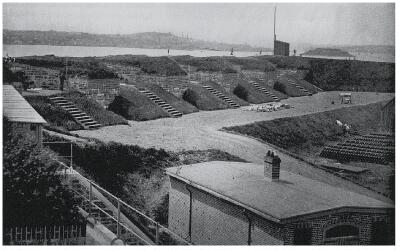
Nova Scotia

Halifax
NO PART OF THE FOLLOWING
ARTICLE AND PHOTOGRAPHS
MAY BE REPRODUCED WITHOUT
PERMISSION FROM THE AUTHOR ©
Situated near the mouth of Halifax Harbour, this large, island is irregularly shaped - being about five kilometres long and one & a half at its widest. It encompasses about 400 hectares with coves, beaches, bogs & marshes, and some open expanses. The remainder is tree covered with its highest point just over 40 metres above the water level.
Local Mi'kmaq (Mic Mac) natives had long used the island as a fishing area, as did the French in the first century of European exploration and settlement. As the rivalry between England and France escalated for possession of the area, frequent skirmishes and outright war led to the desire by both sides to build forts protecting their interests. The French wanted to build Louisbourg on the island but a 1713 agreement allotted mainland Nova Scotia to the British, and so Louisbourg was built on Cape Breton Island, which is also part of Nova Scotia. Louisbourg still stands and with extensive restoration, it has become a major tourist site.
The French had called McNab's Island "Isle de Chibouquetou". This designation came from the native name of "Chebooktook" and was later anglicised to "Chebucto". Until Halifax was founded in 1749, it was the name of the entire harbour. (The "Chebucto" name is still used today and can be found in place & street names in the area. It is also the name of the ISP (Internet Service Provider) with which this webpage is currently hosted, having been derived from that early name.) The founder of Halifax was British Colonel Edward Cornwallis, for whom the island was eventually renamed. By 1773 the island was offered for sale and in 1782 it was purchased by Peter McNab for whose last name the island is now known.
Although local natives may have used the island for fun as well as dwellings, the first record of recreational use was in 1762 with a sports team that played quoits - sort of a ring toss/horseshoes game. An area had been cleared with the intention of building fortifications to defend the harbour, but that idea was shelved after The Seven Year's War between England and France ended. The Treaty of Paris was signed in 1763, making the fort unnecessary.
The quoits and subsequent teams would continue to play there over the next century during the island's use for other recreational purposes as detailed below, but by 1863 (1865 from another source), their field was taken in order to start building the Ives Point Battery (Fort Ives) which came to be again deemed necessary for harbour protection.
Construction started the following year and was completed in 1870. Several refurbishments followed, with the first seeing concrete strengthening and an installation of six new 152mm guns, each boasting a nine-kilometer firing radius. Later upgrades saw a maximum gun size of 254mm. Other forts were built on the island in the 1890s, but after World War I, Fort Ives was abandoned. Part of it, including guns, may still be explored today.
|
Fort Ives Mid 1870s 
(Nova Scotia Archives: 222-6907) Here is a view of the fort about half a decade after completion. It sits on what had been the quoits field. In the Upper Right background is seen George's Island, which also has fortifications. In the far background on the left is Halifax, while Dartmouth lies to the far right. |
The McNab family had always been open to visitors partying or picnicking on their island, with many private and public parties & events held there over the years. The family also allowed use of by, or sold property to, those whom wished to initiate commercial establishments. So by the late 1700s, The Mansion House Inn had opened as an additional service to picnickers with Mary Roubalet as the proprietor.
The ensuing years on the island proved so popular with people wanting recreation that in 1844 The Halifax Steamboat Company began a hire service of boats for island outings, thus increasing McNab's popularity even further. Many other events occurred from that point on, but one of note was an 1845 fund-raiser for The Dartmouth Mechanics' Institute which needed a new hall. The event drew between 3 and 4,000 and was so popular another was held in 1846 that saw 6,000 attend. Unfortunately, the organisers did not expect so large a turn-out and facilities were overloaded to the point where they ran out of food & drink. This did not bolster the event's reputation and in 1847 only 1,200 turned up, resulting in it being the last year this picnic was held. The 1845 event is considered to be the first large-scale public use of McNab's Island.
By the 1850s, with excursions there by individuals, companies, or organisations still occurring, entrepreneurs began to really realise the potential of the island and so they applied to the McNab family to establish facilities there. Here are discussions of two that will benefit those interested in amusement areas:
-Woolnough's Pleasure Grounds (Redmond's Pleasure Grounds)
-Findlay's Pleasure Grounds
|
Thanks to Jeff Parsons of Dartmouth, Nova Scotia for
suggesting McNab's amusement parks.
Thanks to -Mike Tilley of McNab's Island Ferry Service in Eastern Passage, Nova Scotia for suggestions regarding further information resources. For more on McNab's Island, see: |
Return to the
Closed Canadian Parks Index
